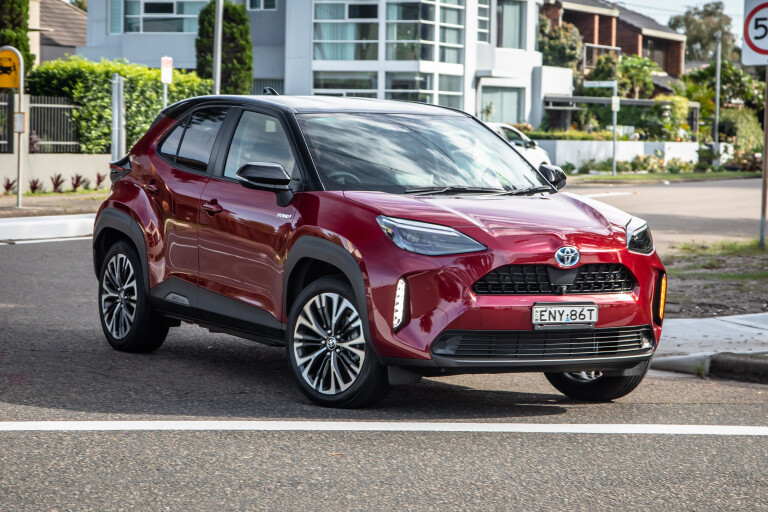
Score breakdown
Things we like
- Hybrid drivetrain
- Safety package
- Fun to drive
Not so much
- Price tag
- Brown interior
- Undercooked infotainment
How do you make a Yaris Cross? There’s a dad joke to be had there, but I’ll leave it to the end. To answer more technically, you take a Toyota Yaris Hybrid hatchback, jack it up a bit, futz about with the interior by adding cloth patterns from the 1990s, whack on a different body, call it a compact SUV and there we are – a Kia Stonic/Hyundai Venue competitor with a Toyota badge and price tag to match. Okay, it was only slightly more technical than the dad joke.
Toyota’s baffling decision to make the much-improved Yaris hatch vastly less affordable than before starts to make business sense when you see the Yaris Cross. And make business sense it has because while the Yaris Cross arrived fairly late to the sales party, it landed in second place pretty damn easily.
The Yaris Cross Urban is one of those badges that milks the SUV pattern while placing it firmly in the buyer’s mind as a city car, with all the cladding of its faux off-road roots but some spangly alloy wheels and a hybrid drivetrain. And, if you like, all-wheel drive, like the one I had.
Pricing and Features

The Yaris Cross range starts off at $26,990 before on-road costs, a reasonable premium over the base Yaris but with a similar spec. Here at the other end in the Urban Hybrid AWD, you’ll be starting at $37,990 before on-road costs, meaning this is a $40K-plus on the road proposition.
If you’re happy with front-wheel drive and without hybrid propulsion, you can dip under forty grand or meet in the middle with a hybrid 2WD. But you’re still fighting with bigger machinery like the Kia Seltos Sport+, Hyundai Kona and even the VW T-Roc. To name just three in this wildly busy segment.
You’ll be getting 18-inch alloys, a six-speaker stereo, single-zone climate control, adaptive cruise control, reversing camera, front and rear parking sensors, keyless entry and start, electric driver’s seat adjustment, sat-nav, auto LED headlights with auto high beam, head-up display, powered folding door mirrors and a tyre repair kit in place of a spare. That’s worth knowing if you’re heading out of the city.
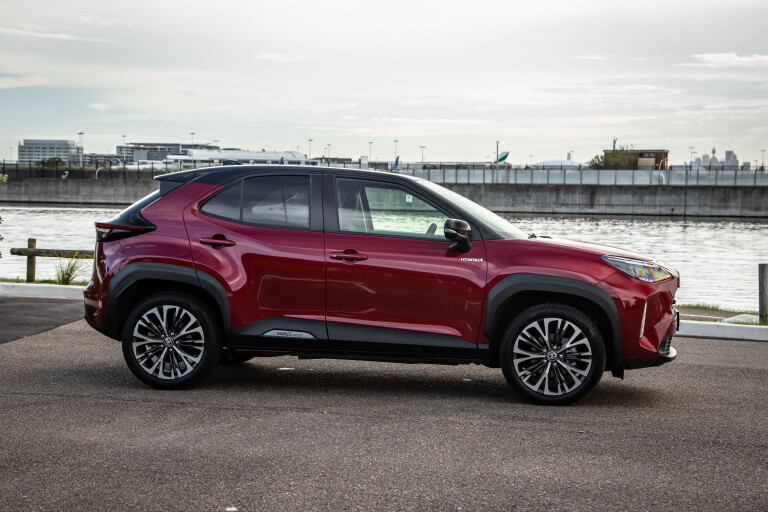
Toyota’s ongoing battle with modernity in the media screen continues, with a washed-out, cheap and small central touchscreen flanked by very cheap plasti-chrome buttons. It’s not befitting the megacorp that is Toyota, but clearly they and most of their customers disagree with me. It does have Android Auto and Apple CarPlay, though, so that’s some compensation.
All of that doesn’t sound like a lot for the money and to be fair, it isn’t. Until you look at the safety spec list that goes on forever. You have eight airbags (including a front centre airbag to prevent head clashes in a side impact), the usual braking, traction and stability systems, blind-spot monitoring, lane departure warning with lane-keep assist, forward collision alert (low-speed), forward auto emergency braking (low speed), rear cross-traffic alert and speed sign recognition. It’s a lot for a small car and it all adds up to a five-star ANCAP rating awarded in September 2021.
All of that doesn’t sound like a lot for the money and to be fair, it isn’t. Until you look at the safety spec list that goes on forever
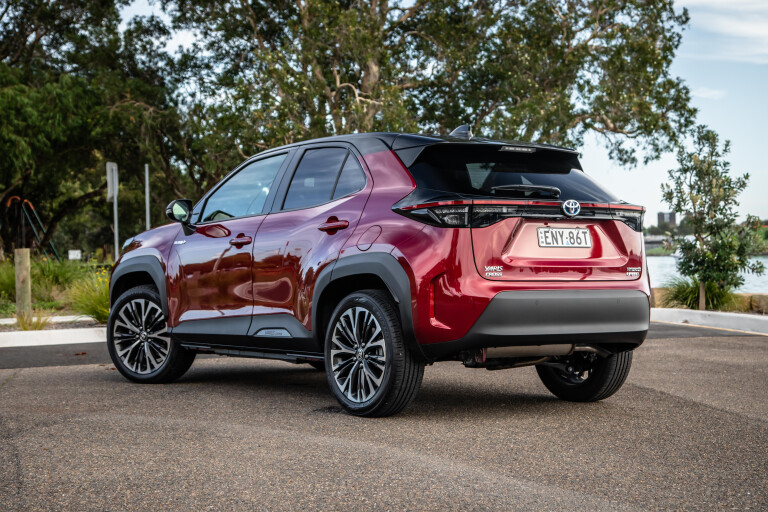
A quick check of the price of an Audi Q2 was in order because the Yaris hatchback in its most expensive form costs almost the same as an Audi A1, but in this case, the gap is much wider. It’s a lot more than a VW T-Cross with all the boxes ticked, though.
The Korean tiddlers are pretty basic sorts of cars with funky looks and a long warranty, especially in the case of the Kia. But the Stonic GT-Line’s twin-clutch transmission is a bit blergh and the 1.0-litre turbo, while fun, won’t get anywhere near the Yaris Cross Hybrid’s fuel consumption.
But the bigger Kona and Seltos are still well within this price range and while they may not punch spec-for-spec with the Yaris, both are better equipped and bigger, though conspicuously missing out on reverse cross-traffic alert except at the top of their respective ranges. You could easily get a fully-specced T-Cross and, if you can find one, a mid-spec T-Roc.
And who could forget the hybrid-powered Toyota C-HR Koba or even GR Sport if you don’t need AWD?
Comfort and Space
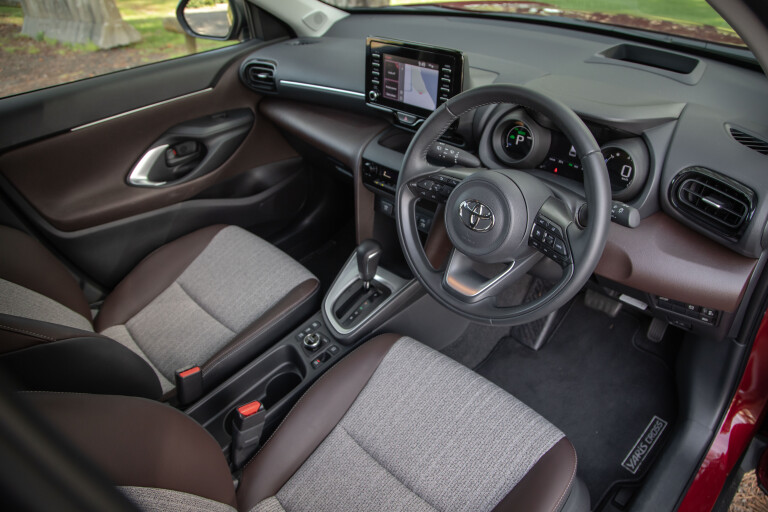
Being a jacked-up Yaris it’s basically what it says on the tin. A Yaris. While it’s slightly bigger on the outside, it’s pretty much the same on the inside…except. Hmmm.
The dash architecture remains the same, with the funny pair of digital dials widely-spaced like the eyes of a Star Wars creature propping up a bar in the back of shot. The central instrument screen is full of useful information and that’s all well and good.

For some reason, Toyota has decided brown is a good interior colour, with solid lashings of it in plastic across the dash, and a fibrous/cardboard material in the door cards and on the seats. The seats themselves have cloth panels sewn in reminiscent of television static from the analogue days. It’s strikingly unpretty and makes me yearn for the daggy 1990s cloth of the top-of-the-range Yaris hatchback.
When you shut the doors they clatter and shudder. While I’m not an 'I need that reassuring thunk' type, it’s a bit unsettling as it’s the kind of noise you expect from a door with frameless windows. There are also a number of unmarked switches that, yes, are window switches but it’s weird that a company that usually pays attention to detail – and does elsewhere on the car – missed these two important things. And like the Yaris hatch, the auto shifter looks completely out of place and from a car you could buy 30 years ago.
For some reason, Toyota has decided brown is a good colour, with solid lashings of it across the dash, and a fibrous material in the door cards
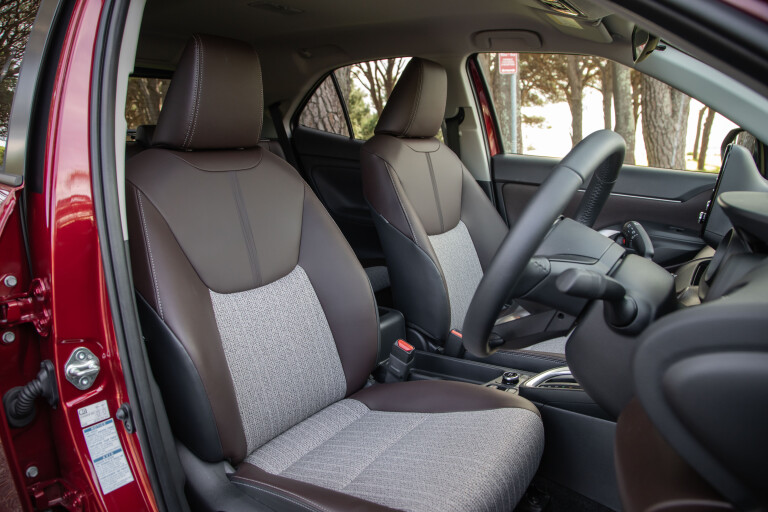
Most of the rest of the cabin is pretty good though. It’s tight, of course, but there are two cup holders up front, and bottle holders in all four doors (although the rears are for smaller vessels). There appears to be space for a fitted removable tray over the cup holders but I couldn’t find anything that suggests it’s available, so that’s one for the 3D-printing crowd. There’s no centre front armrest either, and there’s an open cubby in lieu of a covered bin.
Rear seat passengers have to post themselves through the gap and will find themselves snug behind a six-foot driver. The middle-seat passenger will have you in The Hague before you can blink, which is just as well because if the outboard passengers want cup holders, they have to fold down the entire centre section of the rear seat, which is certainly better than nothing.
No rear air vents, though, or USB ports nor anything much else.
On the Road
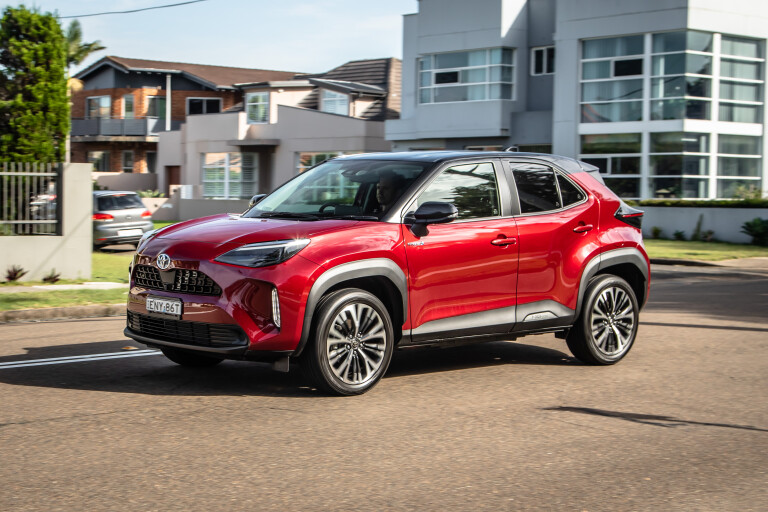
As if I haven’t outlined enough irritating things about the Yaris Cross, Toyota still insists on failing to give us combined power and torque figures for the hybrid system. The 1.5-litre engine musters 85kW at 5500rpm and 120Nm at 3800rpm.
That’s obviously not the whole story because there’s an electric motor with its instant torque and additional power available that makes the Yaris Cross competitively sprightly despite the extra weight over the two-wheel drive ICE versions, while also using hardly any fuel.
As ever, the hybrid system is very good. Toyota has been pounding these out for over two decades now and is doing an excellent job. Smooth transitions between electric and petrol power, a well-integrated automatic continuously variable transmission (CVT) and an exceedingly useful drop in fuel consumption make it all worthwhile.
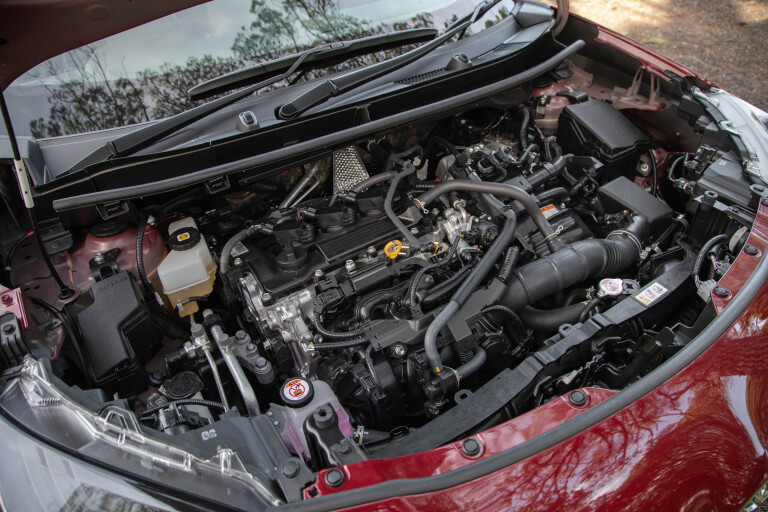
Here in the Yaris, though, the 1.5-litre is a bit rackety and gravelly. It seems obvious that almost no work has gone into making the triple-cylinder sound even vaguely appealing, with the CVT sending it to its power and torque peaks as required and leaving it there to growl at you like a bear with its foot caught in a trap. I love the sound of most three-cylinder engines but I don’t like this one.
There is also an uncharacteristic series of squeaks and chirps from the hybrid system, which I put down to a lack of sound deadening rather than anything sinister. Our resident youth with not-yet broken hearing said it made a lot of high-pitched noises I couldn’t hear and was wondering if I’d left the handbrake on.
One of the reasons for the difference in price to the two-wheel-drive version is that the rear suspension in this specification is double wishbones rather than torsion beams
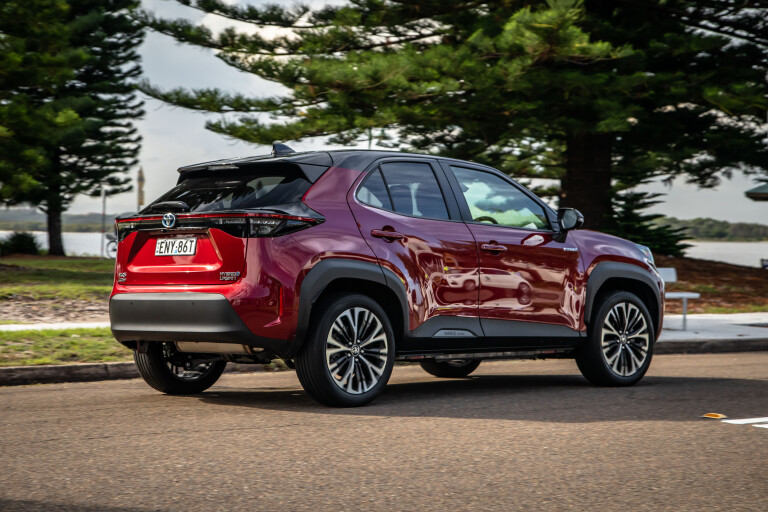
Also irritating are the endless beeps. The lane-keep assist is either wired on meth or sleeping peacefully, and beeps like a bastard when it’s the former. You also have to remember to turn the car off when you’re getting out as the system is too dumb to realise that if you’re locking the car it should shut itself off. Beeping, beeping, always beeping and the beeps all sound the same.
One of the reasons for the substantial difference in price to the two-wheel-drive version is that while they’re all based on Toyota’s hugely impressive TNGA platform, the rear suspension in this particular specification is by double wishbones rather than torsion beams. That woke me up when I read it in the spec sheet and explains why you can have quite a bit of fun on the Dunlop Enasave tyres.

Just over 1300kg isn’t too bad for a modern car laden with so much safety and electrification. Combined with nicely weighted steering, you can have a bit of fun threading this car through the bends. The steering is accurate and the car goes where you want it to while delivering a pretty impressive ride for such a short wheelbase.
Around town, it’s also very good, with the electric motor ensuring you get off the mark quickly and smoothly, which is handy. I love the way it creeps around slowly under electric power, too. You can’t get too excited or the engine kicks in, but it’s a fun game in slow traffic or car parks.
Just over 1300kg isn’t too bad for a modern car laden with so much safety and electrification. Combined with nicely weighted steering, you can have a bit of fun threading through the bends

Our week with the Yaris Cross was pretty busy, including a run to the Blue Mountains and back as well as a lot of city and suburban running. The hybrid drivetrain delivered a mighty impressive 4.0L/100km which in these expensive times is extremely worthy. Most competitors will use twice that, which at the moment makes the difference between covering 100km for around $10 of fuel instead of $20. Toyota has been waiting a long time for an oil crisis and now it’s here…
Ownership
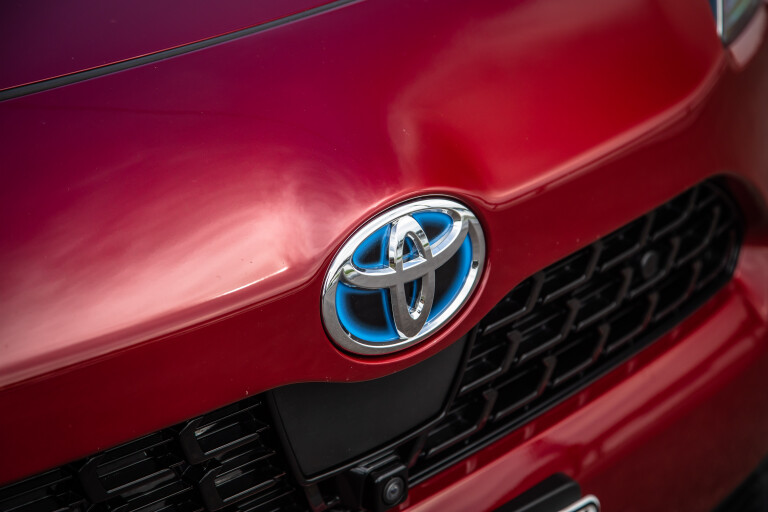
Toyota offers a five-year, unlimited-kilometre warranty on the Yaris Cross and if you keep up servicing at Toyota, you’ll get two more years on the drivetrain. The cover on the hybrid battery extends up to ten years.
Servicing is absurdly cheap at $215 per visit for the first five. Simple, straightforward and cheaper than everyone else.
VERDICT

I can’t quite understand the kerb appeal of the Yaris Cross Urban given its weird interior and high price, but I’m obviously in the minority. It has many, many plus points such as the safety gear, low cost of ownership and that Toyota badge. Cheeringly, you can pay less and still get all of that while not missing out on anything of huge consequence.
It’s odd that this top-spec car has double wishbone rear suspension because I cannot think for a moment that the vast majority of its buyers care. But if you do, that’s the Yaris Cross for you. I just couldn’t justify spending over forty grand on a car with a ropey-looking interior.
Oh, how do you make a Yaris cross? By giving its bigger, younger brother all the attention.
I didn’t promise it would be a good joke, but it’s funny because it’s true.
2022 Toyota Yaris Cross Hybrid Urban specifications
| Body: | 5-door, 5-seat compact SUV |
|---|---|
| Drive: | all-wheel |
| Engine: | 1.5-litre three-cylinder series hybrid |
| Transmission: | CVT |
| Power: | 85kW @ 5500rpm |
| Torque: | 120Nm @ 3800rpm |
| Bore stroke (mm): | 80.5 x 97.6 |
| Compression ratio: | 14.0 : 1.0 |
| 0-100km/h: | 11.4 sec (estimate/claimed) |
| Fuel consumption: | 4.0L/100km (combined) |
| Weight: | 1305kg |
| Suspension: | MacPherson struts front / double wishbone rear |
| L/W/H: | 4180mm/1765mm/1590mm |
| Wheelbase: | 2560mm |
| Brakes: | 283mm ventilated disc front / 265mm solid disc rear |
| Tyres: | 215/50 R18 Dunlop Enasave |
| Wheels: | 18-inch alloy wheels (tyre repair kit) |
| Price: | $37,990 + on-road costs |
Score breakdown
Things we like
- Hybrid drivetrain
- Safety package
- Fun to drive
Not so much
- Price tag
- Brown interior
- Undercooked infotainment



COMMENTS